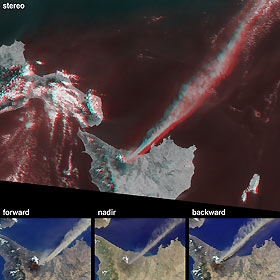
Save this image free of charge
in 800 pixels for layout use
(right click, Save as...)
|
|
Ref : V01596
Theme :
Looking at Earth - Volcanos (181 images)
Title : Stereo View of the Eruption of Mt. Etna
Caption :
These Multi-angle Imaging SpectroRadiometer (MISR) images capture the July 22, 2001 explosion of the Mt. Etna volcano. Etna is located near the eastern coast of Sicily, to the southwest of mainland Italy. Major eruptions have been issuing from both summit and flank vents. Fine ash falling onto the Province of Catania closed the local airport, and a state of emergency was declared for the town of Nicolosi, which was threatened by lava flows from the southern flanks of the volcano. At the bottom of this image set are true-color views from MISR's 70-degree forward-viewing camera, the vertical-viewing (nadir) camera, and the 70-degree backward-viewing camera. Each covers an area of 143 kilometers x 88 kilometers. The upper image is a stereo anaglyph created from the instrument's 70-degree and 46-degree forward views, and covers an area of 438 kilometers x 300 kilometers. To facilitate stereo viewing, the images are oriented with north at the left. Viewing the stereo image in 3-D requires red/blue glasses with the red filter placed over your left eye. Two plumes of differing compositions are seen to be emanating from Etna. The bright, brownish plume drifting southeast over the Ionian Sea is composed primarily of tiny frozen fragments of lava, known as ash. A fainter, bluish-white plume is also visible, especially near the summit, and is most apparent in the 70-degree forward view. It contains very fine droplets of dilute sulfuric acid. In addition to the particulate plumes visible in these images, the volcano also expels gases such as water vapor, sulfur dioxide, and carbon dioxide. Although the Etna volcano is one of the world's most studied volcanoes, it is difficult to classify, being a mixture of overlapping shield and strato volcanoes, partially destroyed by repeated caldera collapse, and partially buried by younger volcanic structures. Eruptions are related to a complex tectonic situation, including subducting plates, numerous major faults intersecting at the volcano, and perhaps also to hot-spot volcanism.
|
|

